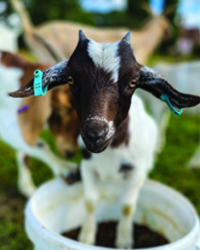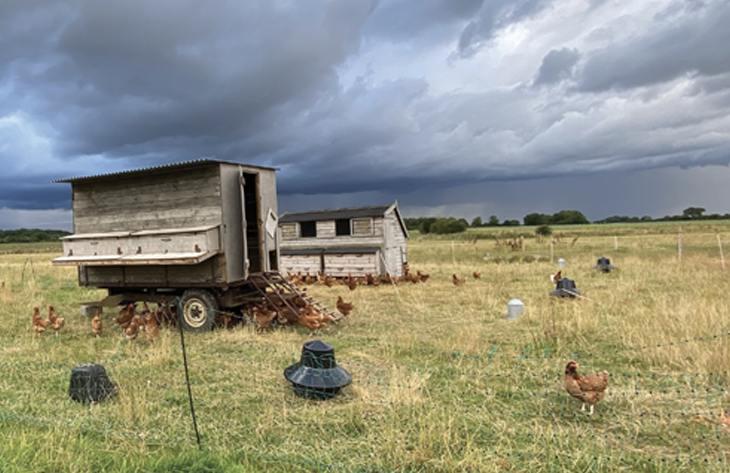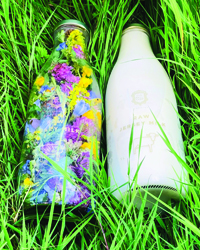Rebecca Mayhew is owner/manager at Old Hall Farm, Woodton, which comprises a farm shop, café, butchery, dairy, and vineyard. Regenerative Agriculture and Holistic Management are at the forefront of the farming system and Rebecca introduces us to the ethos of soil to plate, something that we all need to be increasingly aware of in order to reduce our climate impact.

In this fast-paced world, the regenerative farming and slow food movement is making rapid progress. Fuelled by concerns surrounding the environmental impact of food production – and we aren’t just talking about cow burps here – it’s time for all of us to think holistically about where our food comes from, how it was grown, and what nutritional benefits there are to eating it.
The importance of soil should therefore always be discussed in terms of nutrition. Put simply, if we improve soil health we will improve the nutritional content of our food, with the added bonus that this will drastically improve FLAVOUR as well.
It is also worth noting that improvement in our soils by increasing Organic Matter – that is, effectively, Carbon drawn down from the atmosphere – we’ll also increase soil fertility, reduce flooding, improve resilience in our farming systems, combat global warming and save the planet. All in all, rather a big win-win.
So, how do we go about making a difference for ourselves and the soil in our day-to-day lives? Meat is one of the most expensive things that we buy in our weekly shop and is therefore an easy place to begin. Make every penny count by buying the most nutritious meat that you can, even if it means that you have a little less. This means a little bit of leg work, and lots of conversations. Buying meat from your local butcher rather than a supermarket makes it easier to start the ball rolling. Ask your butcher where the meat that he sells has come from, and what the animal has been fed on. In the case of chicken and pork, buying something soya free is hard to accomplish, although not impossible. However, when it comes to beef and lamb, it is much easier.

Why is dropping soya important? Well, it’s shipped most of the way round the world to get to us and feeding it to animals is a jolly inefficient way to do things. There are also big questions to ask regarding how it is grown as it tends to be part of a monoculture system that is heavily reliant on glyphosate, which is not just proven to be bad for us directly as a carcinogen, but it is also very bad news for the soil on which we so desperately depend.
In order to reduce our climate impact, we have to change the mantra that all meat is bad for the planet when, in fact, grass fed beef and lamb could save us all.
There are huge health benefits to grass fed beef and lamb, which I’ll go into next time. For now, let’s look at the benefits to the soil.
Cutting back on the biggest pollutant – manmade fossil fuels – is very important to reverse climate change. Pasture-based systems utilise what nature can provide in abundance, primarily water and sunshine, and work on no inputs such as chemical fertiliser. There’s less need for large farm machinery, fuelled by diesel, as the cattle and sheep harvest their own food in the most natural way.
To contrast, factory farms providing grain-based diets feed protein using habitat destroying foods such as soya and conventionally grown cereals. A lot of the soil biology is destroyed due to excess tillage and use of chemicals.
Historically, our farmland was a mixture of forage, vegetation, grass, and woodland that would have been home to huge varieties of native plants, insects, and animals – true biodiversity, something that we now lack due to the intensive mono-crop systems which have destroyed these delicate habitats.
By introducing different grasses, herbs, legumes, and clovers that build soil organic matter, this helps to feed the soil and allows biodiversity to bloom. Cattle and sheep are then holistically grazed over the land, in small paddocks with relatively high numbers but moved quickly around the farm. This mimics what herds would do in the wild. This grazing strategy puts huge amounts of nutrients back into the soil and provides us with healthily grown food to eat.
Pasture fed beef and lamb is also far better for us, with much greater amounts of vitamins and healthy fats, and you’ll also find higher levels of beneficial minerals including zinc, iron, phosphorus, potassium, and sodium – all essential for good health.
Can pasture fed animals feed the world? Joel Salatin, who is a shining light in the world of regenerative agriculture, suggests that not only can grass-fed animals feed the world but it’s the only system that will. “The industrial food paradigm views life from a mechanical point of view,” he says. “Food is a machine and the way they go about producing it depletes the soil and burns up energy. The regenerative way of producing food is based on abundance, not depletion. We rejuvenate the soil and lock up carbon so that food can continue to be produced.”

Needless to say, pasture-fed dairy products and pastured eggs are also available, albeit a little harder to find. Again, dairy from purely pasture-based systems is much higher in nutrients than dairy from herds fed with conventional concentrated food rations, and when dairies use mob or holistic grazing strategies, the benefits for the soil are endless. Pastured chickens live in mobile coops that travel behind the cattle, eating any parasites and fertilising the soil as they go. Combine this with a soya-free diet and you really have got a proper soil building team!
Of course, when it comes to a balanced diet, we can’t survive on meat alone, and buying fruit and vegetables can be trickier. Seek out your local farm share or veg box scheme – there are several of these in East Anglia – and by doing so not only will you support local people, but you’ll be supporting healthy systems for soil and nutrients as well. Farmer’s markets are also an excellent place to buy local, regeneratively, chemical-free food, and there’s always time for a good yarn, to discover the story of what goes on your plate, and the soil that it came from.
If you’d like to learn more about regenerative farming before the next edition of nourish is published, then I can recommend watching Kiss The Ground on Netflix, and Allan Savoury’s TED talk from 2013 – but do expect your mind to be blown!
- Old Hall Farm is home to the acclaimed Jersey Goddesses as well as Bruce the Emu. Their farm shop is open seven days a week. Watch this space for courses and tours later in the year. For more information visit www.oldhallfarm.co.uk
- Old Hall Farm have shared their recipe for a delicious blackberry crumble! Do let us know if you try it!











[…] • £4.50 for 200g oldhallfarm.co.uk […]